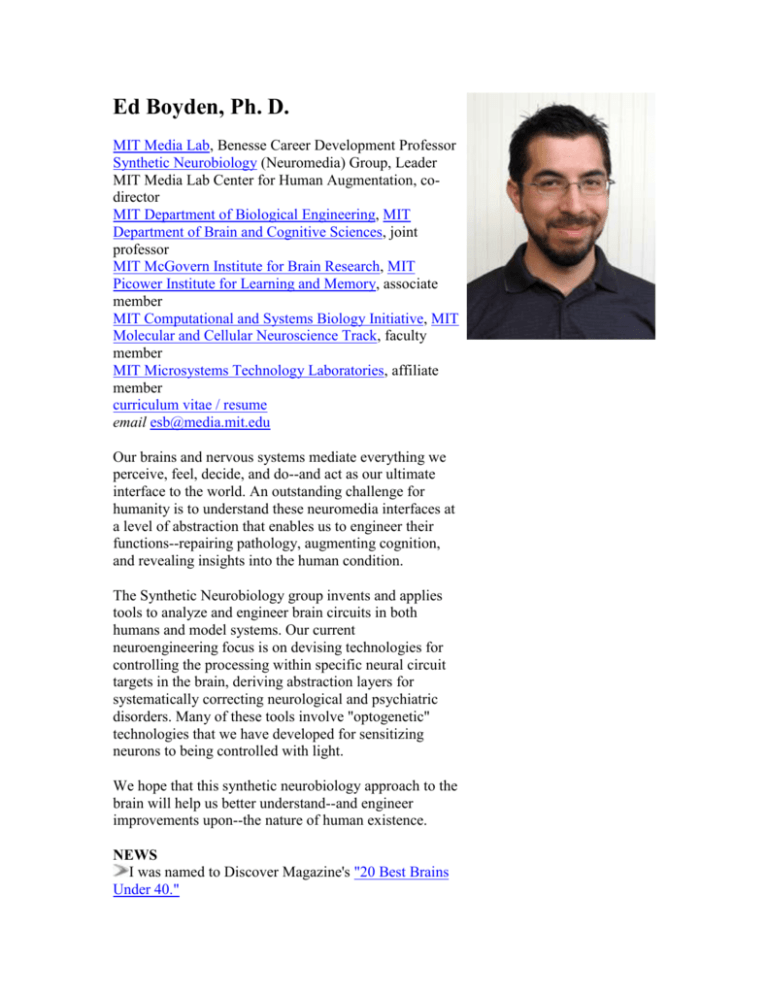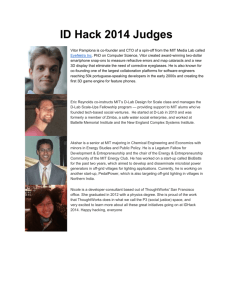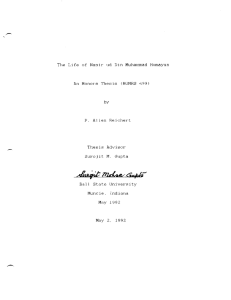ed boyden 2
advertisement

Ed Boyden, Ph. D. MIT Media Lab, Benesse Career Development Professor Synthetic Neurobiology (Neuromedia) Group, Leader MIT Media Lab Center for Human Augmentation, codirector MIT Department of Biological Engineering, MIT Department of Brain and Cognitive Sciences, joint professor MIT McGovern Institute for Brain Research, MIT Picower Institute for Learning and Memory, associate member MIT Computational and Systems Biology Initiative, MIT Molecular and Cellular Neuroscience Track, faculty member MIT Microsystems Technology Laboratories, affiliate member curriculum vitae / resume email esb@media.mit.edu Our brains and nervous systems mediate everything we perceive, feel, decide, and do--and act as our ultimate interface to the world. An outstanding challenge for humanity is to understand these neuromedia interfaces at a level of abstraction that enables us to engineer their functions--repairing pathology, augmenting cognition, and revealing insights into the human condition. The Synthetic Neurobiology group invents and applies tools to analyze and engineer brain circuits in both humans and model systems. Our current neuroengineering focus is on devising technologies for controlling the processing within specific neural circuit targets in the brain, deriving abstraction layers for systematically correcting neurological and psychiatric disorders. Many of these tools involve "optogenetic" technologies that we have developed for sensitizing neurons to being controlled with light. We hope that this synthetic neurobiology approach to the brain will help us better understand--and engineer improvements upon--the nature of human existence. NEWS I was named to Discover Magazine's "20 Best Brains Under 40." Want to support new, systematic approaches for treating neural disorders? Interested in research or technical jobs in the Synthetic Neurobiology Group? We have recently been profiled in the Discovery Channel's Best 5 Science Moments of the Year, and awarded a NIH Director's New Innovator Award, an inaugural Society for Neuroscience 'Research Award for Innovation in Neuroscience', an Alfred P. Sloan Research Fellowship, a NARSAD Young Investigator Award, a Wallace H. Coulter Early Career Award, and a slot in Technology Review's Top 35 Innovators Under Age 35. Technologies for controlling neural circuit dynamics Lentivirus production protocol for in vivo neural gene targeting Millisecondtimescale optical control of neural dynamics in the nonhuman primate brain Simple hardware platforms for bi-directional optical control of neurons and excitable cells Multiple-color optical activation, silencing, and desynchronizati on of neural activity ("optogenetics" ), with halorhodopsin (Halo, NpHR) and Channelrhodop sin-2 (ChR2) Millisecondtimescale optical activation of neurons with ChR2 ("optogenetics" ) OpenStim Noninvasive Brain Stimulator - open transcranial magnetic stimulation (TMS) Blog Classes Inventions My Blog, hosted by Neurotechnolog Principles of Technology Review y Ventures Neuroengineeri MAS.883 / ng MAS.881 / 9.455 / 15.128 / 9.422 / 20.452 20.454 (Fall (Fall 2008) 2008) Medical devices, information technologies, and uses for physics Task-specific neural mechanisms of memory encoding Selective engagement Differential of plasticity generalization of mechanisms for oppositely-directed Distributed plasticity Mechanistic for information interaction of old and encoding new encoded motor memory storage learned changes memories The physics of computation, and the computation of physics 3D mouse interface using electric fields and OpenGL Tabletop NMR FPGA-based RF quantum tag reader computing (Master's thesis) (Master's thesis) MEMS accelerometer using quantum tunneling A physics-based 'Everything I animation engine learned at MIT' Tree-based Control software machine learning for the MIT for violin physics ORCA simulation autonomous submarine Photographs from selected adventures Southwest U.S., Thailand, 2002 2001 Point Reyes, CA, Monterey, CA 2002, 2003 Mendocino, CA, 2003 San Juan Islands, Patagonia, Chile, Kauai, Hawaii, Seattle, WA, 2004 2006 2003 Useful resources Conversion Factors, Material Properties and Constants phone 617 324-3085 - fax 617 253-7035 - address Massachusetts Institute of Technology - MIT Media Lab - Room E15-430 - 20 Ames St. - Cambridge, MA 02139 Copyright © 1995-present, Ed Boyden Mark S. Humayun , MD Professor Dr. Humayun completed his medical degree at Duke University Medical School. While in his residency training at Duke Eye Center, Dr. Humayun earned his Ph.D. in Biomedical Engineering at the University of North Carolina at Chapel Hill. He completed his fellowship training in vitreoretinal disease at the Wilmer Ophthalmological Institute at Johns Hopkins. Dr. Humayun served most recently at the Wilmer Ophthalmological Institute at Johns Hopkins as an Associate Professor and as Director of the Intraocular Retinal Prosthesis Lab. The focus of this lab is to develop a retinal implant for the blind. He has had a close working relationship with Biomedical Engineering and a number of national labs such as Naval Research Laboratory and Oakridge National Laboratory. CONTACT INFORMATION 1450 San Pablo Street DEI 3615 Los Angeles, CA 90033 Phone: 323-442-6335 Fax: 323-442-6519 E-mail: humayun@usc.edu Robert F. Kirsch, Ph.D. Associate Professor Office: Phone: Fax: Email: Mail Address: Room 115 Wickenden Building (216)-368-3158 / 216 778-4139 (216)-368-4969 / 216 778-4259 rfk3@case.edu Room 309 Wickenden Building 10900 Euclid Avenue Cleveland, OH 44106-7207 Selected links: • Department of Biomedical Engineering • PubMed Citations >> Research Summary My research focuses on the mechanics and control of human movement. In this work, I study the properties of the intact body to determine basic mechanical properties and to understand how the nervous system normally controls movement. I also study individuals with neurological disorders such as spinal cord injury to determine how to restore movements using electrical stimulation of paralyzed muscles and/or surgical procedures such as muscle tendon transfers. Current projects are focusing on restoring shoulder movements to individuals with cervical spinal cord injuries, providing individuals with paraplegia with the ability to stand without assistance, and understanding the natural neural control of human shoulder and elbow movements. Several different methods are used to study these issues, including computer-based modeling of the human shoulder/elbow and of the human lower extremities/trunk, artificial neural networks to implement nonlinear feedforward controller elements, and system identification to characterize the stiffness properties of the human arm. My research is supported by the National Institutes of Health, the Spinal Cord Research Foundation, the Department of Veterans Affairs, and the Whitaker Foundation.







